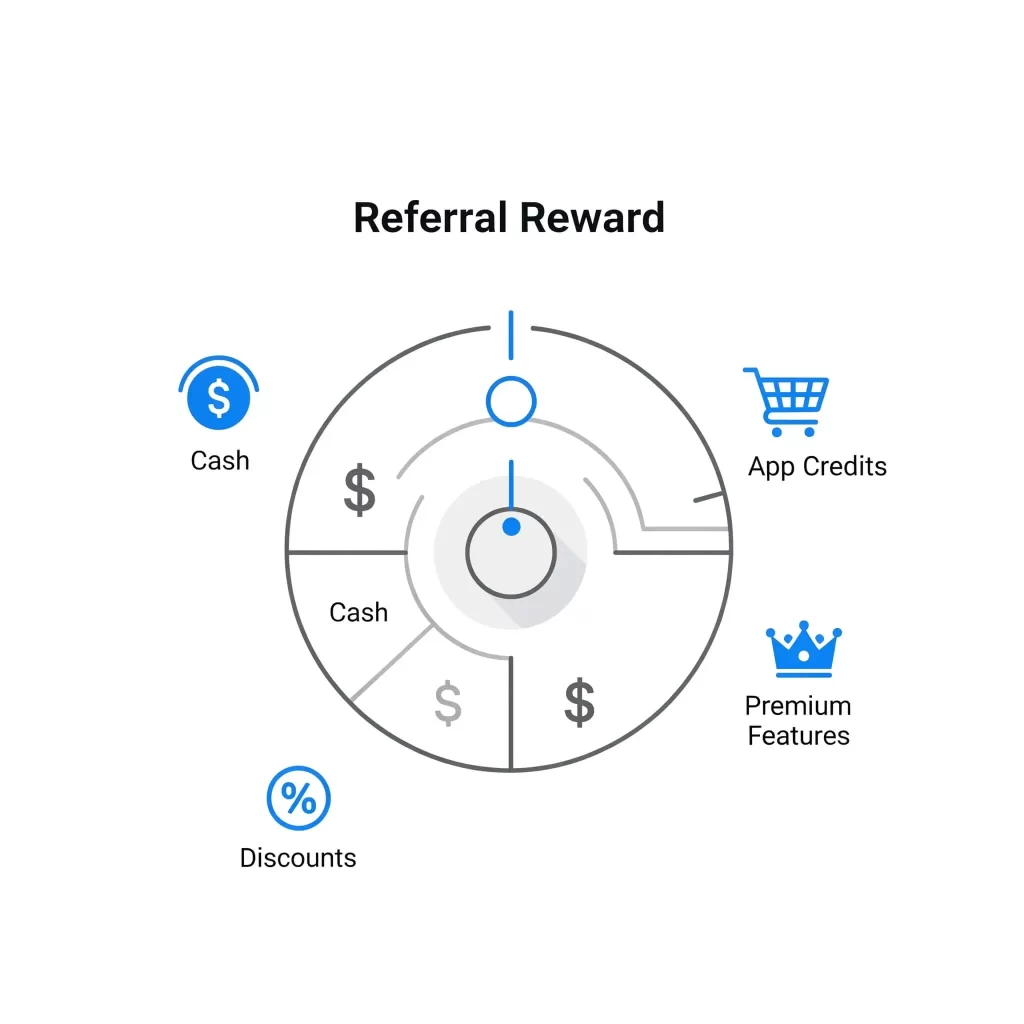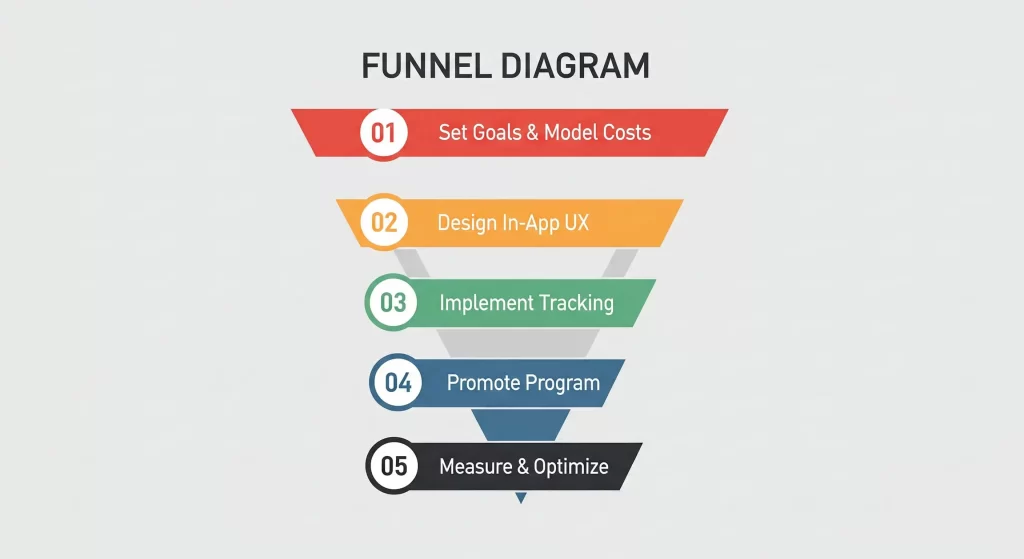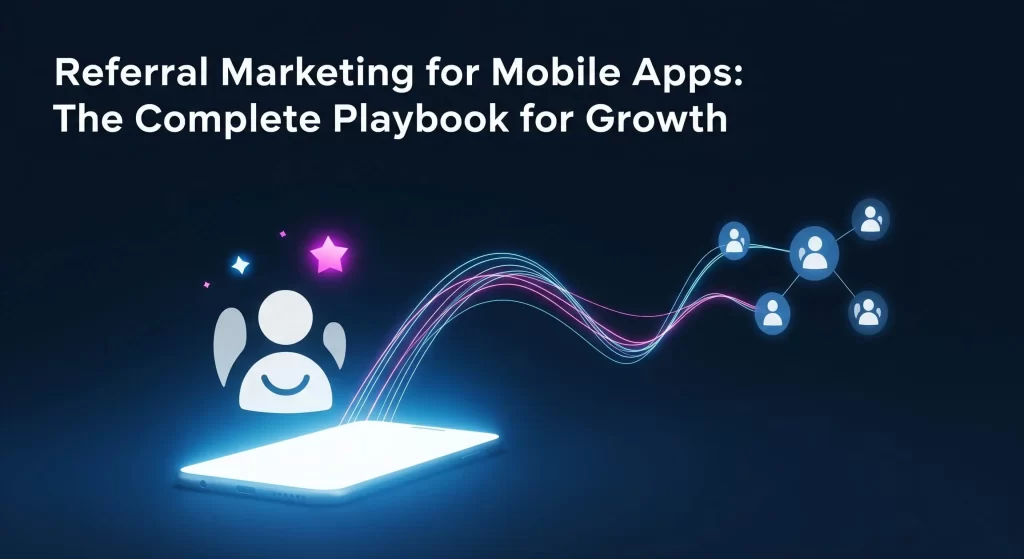In the competitive world of app growth, what if you could turn your happiest, most engaged customers into your most effective and profitable sales team? That is the core promise of referral marketing for mobile apps. A well-engineered mobile app referral program is more than just a marketing campaign; it’s a sustainable, scalable growth engine that delivers users with a lower customer acquisition cost (CAC) and a higher lifetime value (LTV).
The trust inherent in a friend’s recommendation is something no advertisement can buy. But building a system that can reliably track, reward, and scale these recommendations in the complex mobile ecosystem is a significant challenge. This playbook will provide the definitive, step-by-step guide on how to create a referral program for an app that your users will love and that will drive meaningful growth for your business.
Table of Contents
The Psychology of a Successful Referral Marketing for Mobile Apps
At its heart, referral marketing for mobile apps works because it leverages one of the most powerful forces in human decision-making: trust. A recommendation from a friend cuts through the noise of traditional advertising because it comes with built-in social proof. We inherently trust the judgment of people we know. For inspiration and we have put together 15+ Mobile App Referral Program Examples that can help you understand what might work for you product
Also, to turn this latent trust into a scalable program, your offer must be compelling. A successful referral offer has three essential components:
- It must be Simple: The user must be able to understand the offer in five seconds or less. “Give $10, Get $10” is instantly understandable. Complex rules and conditions create friction and kill motivation.
- It must be Valuable: The reward must be meaningful to both the sender and the recipient. A 5% discount might not be enough to motivate action, but a free month of premium service could be a powerful incentive.
- It must be Dual-Sided: The most successful programs reward both the referrer and the new user. This transforms the invitation from a selfish act (“Help me get a reward”) to a generous one (“Here’s a gift for you that also helps me”).
Designing Your Offer: The 4 Key Decisions
Before you build anything, you must architect your offer. These four key decisions will define the economics and effectiveness of your entire mobile app referral program.

Decision 1: What is the Reward?
The reward is the fuel for your referral engine. It should be valuable to your users and sustainable for your business.
- Cash or Gift Cards: Highly motivating and universally understood. Best for apps where the direct monetary value is clear (e.g., finance, e-commerce).
- App Credits: Excellent for driving engagement and retention. The “cash” can only be spent within your ecosystem (e.g., Uber credits, Airbnb travel credits).
- Premium Features: A very cost-effective reward. Unlocking a premium feature or offering a free month of a subscription can have a high perceived value with a low marginal cost to you. (e.g., Dropbox’s extra storage).
- Discounts: Simple to implement, but often the least motivating unless the discount is substantial.
Decision 2: Who Gets the Reward?
This determines the social dynamic of the share.
- Referrer Only: Motivates the sender but gives the friend no reason to sign up. This can feel transactional and selfish.
- Friend Only: A purely altruistic model. Some users might share, but there is no direct incentive for the referrer to do so repeatedly.
- Dual-Sided (Recommended): Both parties benefit. This is the gold standard. It creates a win-win scenario that makes the referrer feel like they are giving a gift, dramatically increasing share rates.
Decision 3: What is the Conversion Event?
This is the most critical decision for the profitability of your program. When, exactly, is the reward earned?
- On Install: The lowest friction, but also the riskiest. It can lead to low-quality users and fraud, as users are rewarded simply for downloading the app.
- On Sign-up / Activation: A much better model. The reward is triggered when the new user creates an account or completes a key onboarding step. This ensures you are rewarding for a baseline level of user intent.
- On First Purchase / Subscription: The most secure and profitable model. The reward is only paid out after the new user generates direct revenue. This guarantees a positive ROI on every single referral.
Decision 4: What are the Rules?
Define the terms of your program clearly to prevent confusion and abuse.
- Eligibility: Is the program for all users or only paying customers? Is the offer valid only for new customers?
- Reward Limits: Is there a cap on how many rewards a user can earn?
- Expiration: Do referral credits or discounts expire?
These rules should be easily accessible from your in-app referral dashboard.
The Technical Foundation for Mobile App Referrals
Successful referral marketing for mobile apps lives or dies by its technical reliability. If a user refers a friend and the tracking fails, they don’t get their deserved reward. When this happens, you haven’t just lost a conversion; you’ve broken the trust of one of your most valuable customers. This is why it is so critical to understand what the best referral marketing software is for your app
The central challenge is the “App Store black box.” The journey from a referral click to an in-app conversion is broken by the App Store, which does not pass attribution data through to the app after an install. This makes mobile referral tracking uniquely difficult compared to the web.
This is precisely the problem Tapp was built to solve. Tapp is the purpose-built engine for mobile attribution. It uses deterministic deferred deep linking, the only method that can guarantee every referral is accurately attributed from the initial click, through the App Store install, all the way to the final conversion event inside your app.
Relying on anything less than deterministic tracking introduces guesswork into your program. With Tapp, you can build your customer referral program on a foundation of 100% accuracy, ensuring every user is rewarded correctly, every time.
The Playbook: How to Build Your Program Step-by-Step
With your offer designed and your technical foundation chosen, it’s time to build. Treat your referral program like a core product feature, not a one-off campaign.

Step 1: Set Your Goals & Model Your Costs
Define what success looks like. Is your goal to drive a certain number of new subscribers per month? To lower your blended CAC by 20%? Set a clear goal. Then, model the costs. Ensure that the LTV of a referred customer is significantly higher than the cost of the rewards you are paying out for that referral.
Step 2: Design the In-App User Experience (UX)
The referral program should be a seamless, integrated part of your app experience.
- Promote it Contextually: Don’t just hide the referral program in a settings menu. Prompt users to refer friends at moments of high satisfaction, such as after they complete a key action, leave a positive review, or have been a loyal user for a certain period.
- Create a Referral Hub: Build a dedicated section in your app where users can track their referrals. This dashboard should clearly show their unique referral link, how many friends they’ve invited, which ones have converted, and the rewards they’ve earned.
Step 3: Implement the Tracking with Tapp
This is the core engineering work. The flow is straightforward:
- Generate Unique Links: Use the Tapp API to generate a unique referral link for every user.
- Attribute the Install: When a new user opens the app for the first time, the Tapp SDK retrieves the original referrer’s ID from the link.
- Track the Conversion Event: When the new user completes the target action (e.g., makes a purchase), you fire a Tapp tracking event.
- Trigger the Reward: Tapp’s system confirms the conversion, and your backend can then reliably trigger the reward for both the referrer and the new user.
Step 4: Promote Your Program
Once built, you need to let your users know about it. Announce the launch of your referral program to your existing user base through a multi-channel campaign:
- Email Announcement: Send a dedicated email to your users explaining the new program and how they can benefit.
- Push Notifications: Target engaged users with a push notification inviting them to check out the referral program.
- In-App Messages: Use in-app pop-ups or banners to promote the program contextually.
Step 5: Measure & Optimize
A referral program is not “set it and forget it.” Continuously track your key performance indicators (KPIs) to optimize performance:
- Invite Rate: What percentage of your active users send at least one referral?
- Share Rate: How many shares does an average referring user send?
- Click-to-Install Rate: What percentage of shared links are clicked on?
- Install-to-Conversion Rate: What percentage of referred installs result in a successful conversion event?
- Program ROI: Is the LTV of your referred users greater than the cost of the rewards?
- Iterative Testing: You need to constantly look to optimise and in our guide: How to A/B Test a Referral Program we take you through every step to ensure you will master referral marketing for mobile apps
Frequently Asked Questions (FAQ)
What is the difference between referral and affiliate marketing for mobile apps?
While similar, a mobile app referral program is typically aimed at your existing customers, rewarding them for inviting their friends and colleagues. An affiliate program is a more formal partnership, usually with professional marketers or content creators, who promote your app to their broader audience. For more, see our guide to Affiliate Marketing for Mobile Apps.
What is a good conversion rate for a mobile app referral program?
This varies widely by industry and offer, but a healthy click-to-install rate is often in the 10-20% range. The more important metric is the install-to-action rate. A rate of 20-40% for a valuable action like a trial start is considered very strong.
How can I prevent referral fraud?
The best way is to tie your reward to a high-intent conversion event, like a first purchase, rather than just an install. Additionally, your system should have checks to prevent users from referring themselves with different email addresses and to flag users who refer an unusually high number of new users who never engage with the app.
Is a dual-sided reward always better?
In almost all cases, yes. A dual-sided reward transforms the psychology of the share from a selfish request to a generous gift. This dramatically increases the likelihood that a user will share, as it benefits their social standing with their friends.
Conclusion
A high-growth customer referral program is one of the most powerful and profitable assets you can build for your app. It’s a defensible growth channel that leverages the trust of your best users to acquire more users just like them. But it’s crucial to treat it as a product, not a campaign. The success of your referral marketing for mobile app growth is built on a foundation of a well-designed offer, deep user trust, and flawless technical reliability.
You cannot build a successful program on a foundation of broken tracking. Tapp provides the purpose-built, unbreakable attribution engine you need to ensure every referral is tracked accurately and every user is rewarded correctly, allowing you to build with confidence.
Your best users are your best marketers. Build them a referral marketing for mobile apps program they’ll love on a platform you can trust. Sign up for your free Tapp account to get started.
For a deeper dive into the engineering principles behind this, read our Engineer’s Guide to Creating Viral Loops for App Growth.

